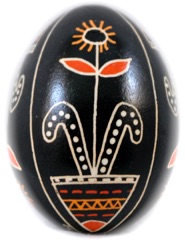Pagan Religious Motifs
Язичницькі Мотиви
Pagan Religious Motifs
Язичницькі Мотиви

Religious symbols are quite common on pysanky. In ancient times, symbols were drawn to the old gods, including Perun, Dazhboh, the Serpent and the Berehynia.
The Berehynia and the Serpent are seen frequently on folk pysanky particularly those of Podillia. They are the most ancient of our gods, the mother goddess and the god of water. Later Slavs expanded on their pantheon and organized it in a more patriarchal manner, mirroring the pantheon of their trading partners, the Greeks. Dazhboh, the god of the sun (and Yarylo, one of his aspects) was particularly important for a largely agricultural society.
In those pre-christian times, the sun god (Dazhboh) was the most important of all the deities; birds were the sun god's chosen creations, for they were the only ones who could get near him. Humans could not catch the birds, but they did manage to obtain the eggs the birds laid. Thus, the eggs were magical objects, a source of life. The egg was also honored during rite-of-Spring festivals – it represented the rebirth of the earth. The long, hard winter was over; the earth burst forth and was reborn just as the egg miraculously burst forth with life. The egg, therefore, was believed to have special powers. (For a better understanding of the old religion, look here.)
Below are brief descriptions of many Pagan religious motifs and symbols. For more detailed information and examples of pysanky with these motifs, go to the corresponding pages in the Pagan Religious Motifs Gallery.
Ruzha (Eight Pointed Star)
Pysanky often depict an eight-sided star, which is a symbol of the sun god Dazhboh.






Berehynia (Great Goddess)
The goddess motif is an ancient one, and most often found in pysanky from Polissia, Bukovyna and Podillia. The berehynia was believed to be the source of life and death. On the one hand, she is a life giving mother, the creator of heaven and all living things, and the mistress of heavenly water (rain), upon which the world relies for fertility and fruitfulness. On the other hand, she was the merciless controller of destinies.
Berehynia depictions fall into three general categories:
“BOHYNIA” The goddess is sometimes depicted with arms upraised, and the arms vary in number but are always in pairs: 2, 4 or 6.

Pysanky with this motif were called “bohyn’ky” (богиньки, little goddesses) or “zhuchky” (жучки, beetles), the latter because they are similar in appearance to the Cyrillic letter Ж (zh). You can see examples of the oranta-style berehynia in these two examples from Binyashevsky (Podillya, Kyivshchyna), and the one at the top of this page (Volynian Polissia):


You can see more examples on the “Bohynia” page.
“VAZON” Sometimes the berehynia has become abstracted, and is represented by a plant–vazon–the tree of life. Her arms become the branches and flowers, and she is firmly rooted in a flowerpot.

You can see more examples on the “Vazon” page, but here are a few examples:



“KUCHERI” The most common depiction of the great goddess is a composition containing “kucheri” (curls). The berehynia may be seen perched on a curl (left), or a curl may be given wings (right). Sometimes one curl is mirror-imaged, giving an “S” shape with wings (below, right). Often there is a crown on the berehynia’s head. These compositions are given the folk names of “queen,” “princess,” “scythe,” “drake,” or simply “wings.”


These are two examples from Binyashevsky:


For more detailed information and examples of pysanky with berehynia motifs, go here.
Back to MAIN Symbolism home page.
Back to MAIN Pysanka home page.
Back to Pysanka Index.
